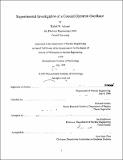| dc.contributor.advisor | Richard Temkin. | en_US |
| dc.contributor.author | Advani, Rahul N | en_US |
| dc.contributor.other | Massachusetts Institute of Technology. Department of Nuclear Engineering. | en_US |
| dc.date.accessioned | 2014-03-06T15:37:38Z | |
| dc.date.available | 2014-03-06T15:37:38Z | |
| dc.date.copyright | 1999 | en_US |
| dc.date.issued | 1999 | en_US |
| dc.identifier.uri | http://hdl.handle.net/1721.1/85377 | |
| dc.description | Thesis (Ph.D.)--Massachusetts Institute of Technology, Dept. of Nuclear Engineering, 1999. | en_US |
| dc.description | Includes bibliographical references (leaves 157-165). | en_US |
| dc.description.abstract | This thesis presents experimental results of a megawatt power level, 140 GHz coaxial gyrotron oscillator. The coaxial gyrotron has the potential to transport very high power electron beams and thus achieve higher microwave output power levels than conventional gyrotrons. A TE2 ,3 coaxial gyrotron was designed to operate at 95 kV, 76 A. This tube was tested to high power with the first high power Inverted Magnetron Injection Gun (IMIG). The IMIG electron gun was tested to 10 MW (105 kV, 93 A), which is the highest power level for a non-relativistic gyrotron gun. Operation of the coaxial gyrotron oscillator yielded power levels of greater than 1 MW in two different configurations: with the coaxial conductor (at 92kV, 70 A, and 16% efficiency) and without the coaxial conductor (85 kV,65 A, and 18% efficiency). We also successfully operated this tube in three configurations (empty cavity, radial output, and axial output) with no beam interception. We observed regimes of dominant single mode and multi-mode operation. We also identified electron beam asymmetries and tube alignment as two major issues, which can limit the performance of a coaxial gyrotron. An unexpected source of magnetic field error was found in the magnetization of the stainless steel parts. All these results have led to techniques for improving not only coaxial gyrotrons but also other gyrotron tubes. | en_US |
| dc.description.abstract | (cont.) We also investigated a ferroelectric cathode, which has the potential to achieve higher currents than thermionic cathodes in a simpler, low cost gun. We report the first results on a ferroelectric cathode gun in a magnetron injection gun configuration suitable for use in a gyrotron. It had an annular emitter shape with a diameter of 11.4 cm and a width of 0.25 cm and operated at currents of up to 10 A (1.1 A/cm2) at 8 kV, in 5 Vs flat-top pulses. This result (along with the kiloampere beam obtained at Integrated Applied Physics) demonstrate the scalability of ferroelectric cathodes to large diameter electron beams. Also, the first ever microwaves from a ferroelectric cathode were generated in a collaboration experiment at Tel Aviv University. Finally, we developed a theory to explain the emission process from ferroelectric cathodes. The experiments reported have shown the suitability of ferroelectric cathodes for future microwave generation experiments. | en_US |
| dc.description.statementofresponsibility | by Rahul N. Advani. | en_US |
| dc.format.extent | 165 leaves | en_US |
| dc.language.iso | eng | en_US |
| dc.publisher | Massachusetts Institute of Technology | en_US |
| dc.rights | M.I.T. theses are protected by copyright. They may be viewed from this source for any purpose, but reproduction or distribution in any format is prohibited without written permission. See provided URL for inquiries about permission. | en_US |
| dc.rights.uri | http://dspace.mit.edu/handle/1721.1/7582 | en_US |
| dc.subject | Nuclear Engineering. | en_US |
| dc.title | Experimental investigation of a coaxial gyrotron oscillator | en_US |
| dc.type | Thesis | en_US |
| dc.description.degree | Ph.D. | en_US |
| dc.contributor.department | Massachusetts Institute of Technology. Department of Nuclear Engineering | en_US |
| dc.contributor.department | Massachusetts Institute of Technology. Department of Nuclear Science and Engineering | |
| dc.identifier.oclc | 48749732 | en_US |
